Publishing for Children: McClelland & Stewart's Long Legacy
Tiffanie Ing, Queen’s University
Among the first notable children’s titles that M&S distributed were British 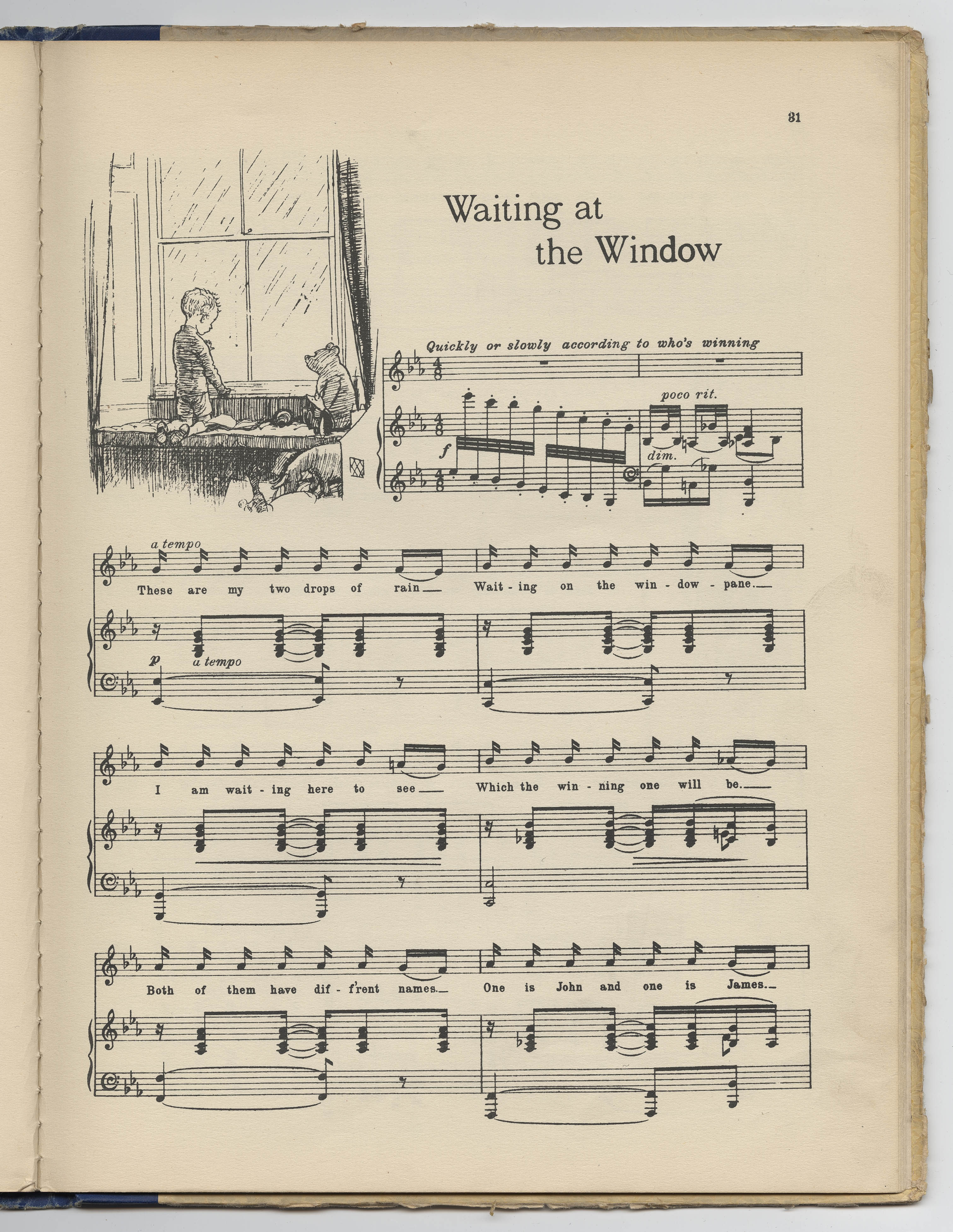 author A.A. Milne’s Winnie the Pooh series (1924-8), illustrated by E.H. Shepard; in addition to these popular books, M&S published music derived from the stories. In the 1930s and 1940s, M&S issued Canadian editions of bedtime stories by celebrated American author and naturalist, Thornton W. Burgess, who created such notable animal characters as Peter Cottontail. M&S retained Canadian copyright to many of these foreign works, and in the 1960s re-issued the Burgess and Milne titles. Other very popular foreign children’s works published by M&S included Rudyard Kipling’s Just So Stories in a volume entitled Kipling Stories and
author A.A. Milne’s Winnie the Pooh series (1924-8), illustrated by E.H. Shepard; in addition to these popular books, M&S published music derived from the stories. In the 1930s and 1940s, M&S issued Canadian editions of bedtime stories by celebrated American author and naturalist, Thornton W. Burgess, who created such notable animal characters as Peter Cottontail. M&S retained Canadian copyright to many of these foreign works, and in the 1960s re-issued the Burgess and Milne titles. Other very popular foreign children’s works published by M&S included Rudyard Kipling’s Just So Stories in a volume entitled Kipling Stories and 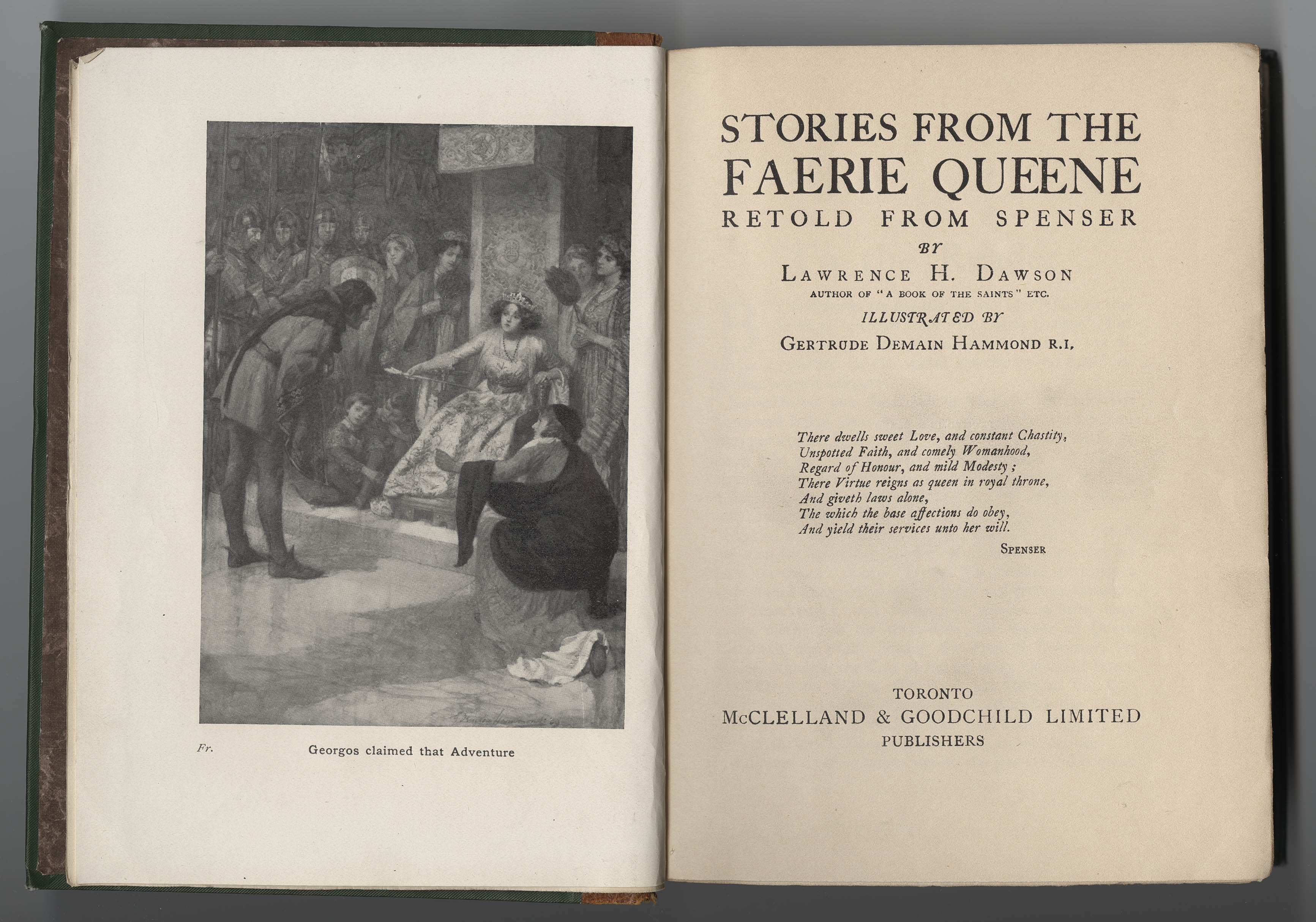 Poems Every Child Should Know (1909), and Edgar Rice Burroughs’s Tarzan stories (1914 onwards) as well as various retellings of classic literature such as Lawrence H. Dawson’s Stories from the Faerie Queene; Retold from Spenser (1911), and Oxford scholar Herbert Lord Havell’s Stories from Thucydides (1911). American educator Kate Douglas Smith Wiggin’s The Birds’ Christmas Carol, an 1887 children’s classic about Carol Bird, a child born on Christmas Day who embodies the spirit of Christmas generosity, was distributed by M&S in 1912.
Poems Every Child Should Know (1909), and Edgar Rice Burroughs’s Tarzan stories (1914 onwards) as well as various retellings of classic literature such as Lawrence H. Dawson’s Stories from the Faerie Queene; Retold from Spenser (1911), and Oxford scholar Herbert Lord Havell’s Stories from Thucydides (1911). American educator Kate Douglas Smith Wiggin’s The Birds’ Christmas Carol, an 1887 children’s classic about Carol Bird, a child born on Christmas Day who embodies the spirit of Christmas generosity, was distributed by M&S in 1912.
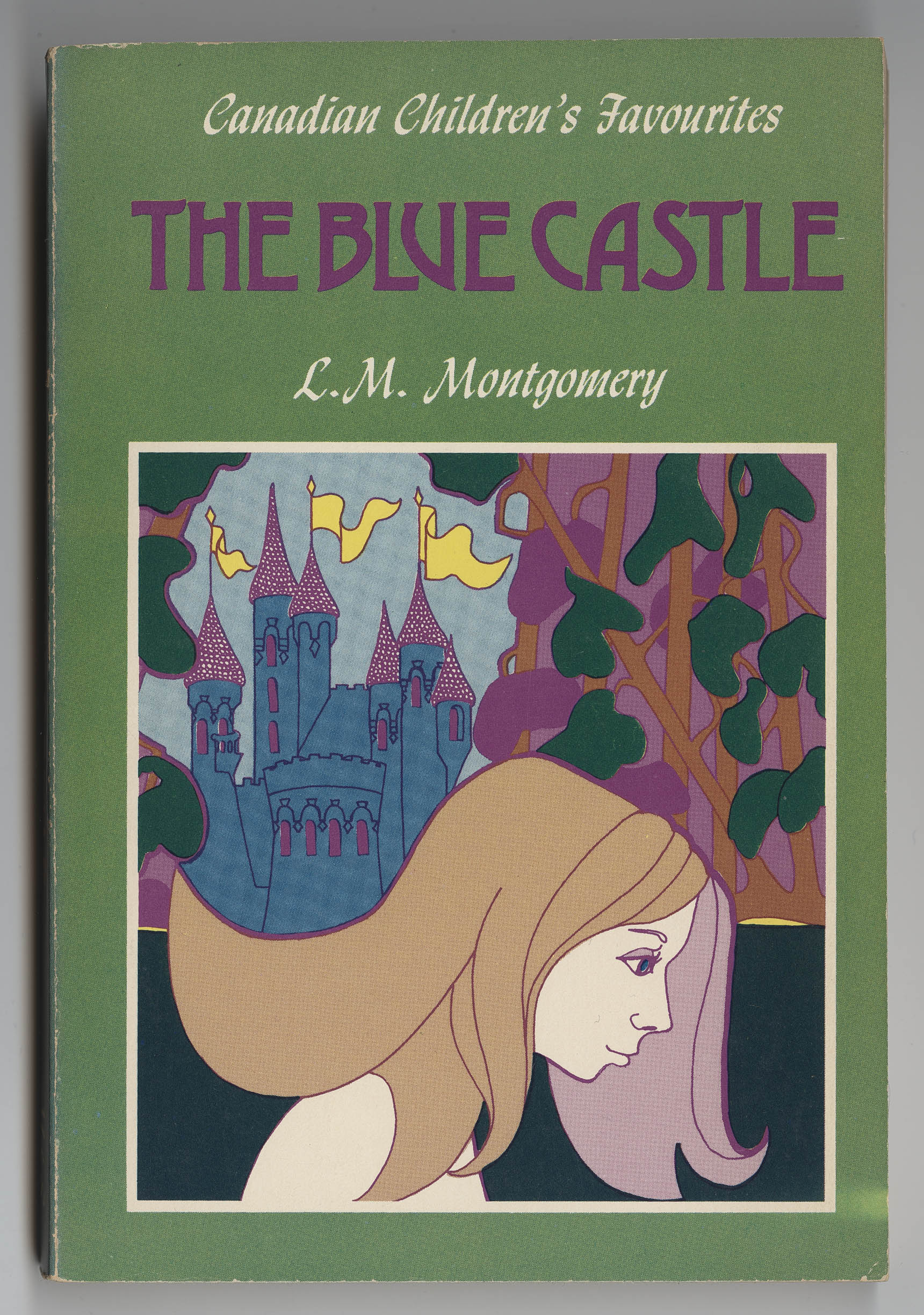 Canadian children’s authors soon were recruited into the M&S fold. One highly successful venture was the publication of works by L.M. Montgomery. Although Anne of Green Gables was issued by American firm L.C. Page in 1908, by the year 1916, M&S (then called McClelland, Goodchild and Stewart) had signed on Montgomery as an author, and went on to publish the sequels, Anne’s House of Dreams (1917), Rainbow Valley (1919), and Rilla of Ingleside (1921) in addition to other Montgomery children’s titles, including Emily of New Moon (1923) and The Blue Castle (1926). Many Montgomery titles were reissued in paper editions by M&S beginning in the early 1970s. Other early M&S children’s titles included
Canadian children’s authors soon were recruited into the M&S fold. One highly successful venture was the publication of works by L.M. Montgomery. Although Anne of Green Gables was issued by American firm L.C. Page in 1908, by the year 1916, M&S (then called McClelland, Goodchild and Stewart) had signed on Montgomery as an author, and went on to publish the sequels, Anne’s House of Dreams (1917), Rainbow Valley (1919), and Rilla of Ingleside (1921) in addition to other Montgomery children’s titles, including Emily of New Moon (1923) and The Blue Castle (1926). Many Montgomery titles were reissued in paper editions by M&S beginning in the early 1970s. Other early M&S children’s titles included 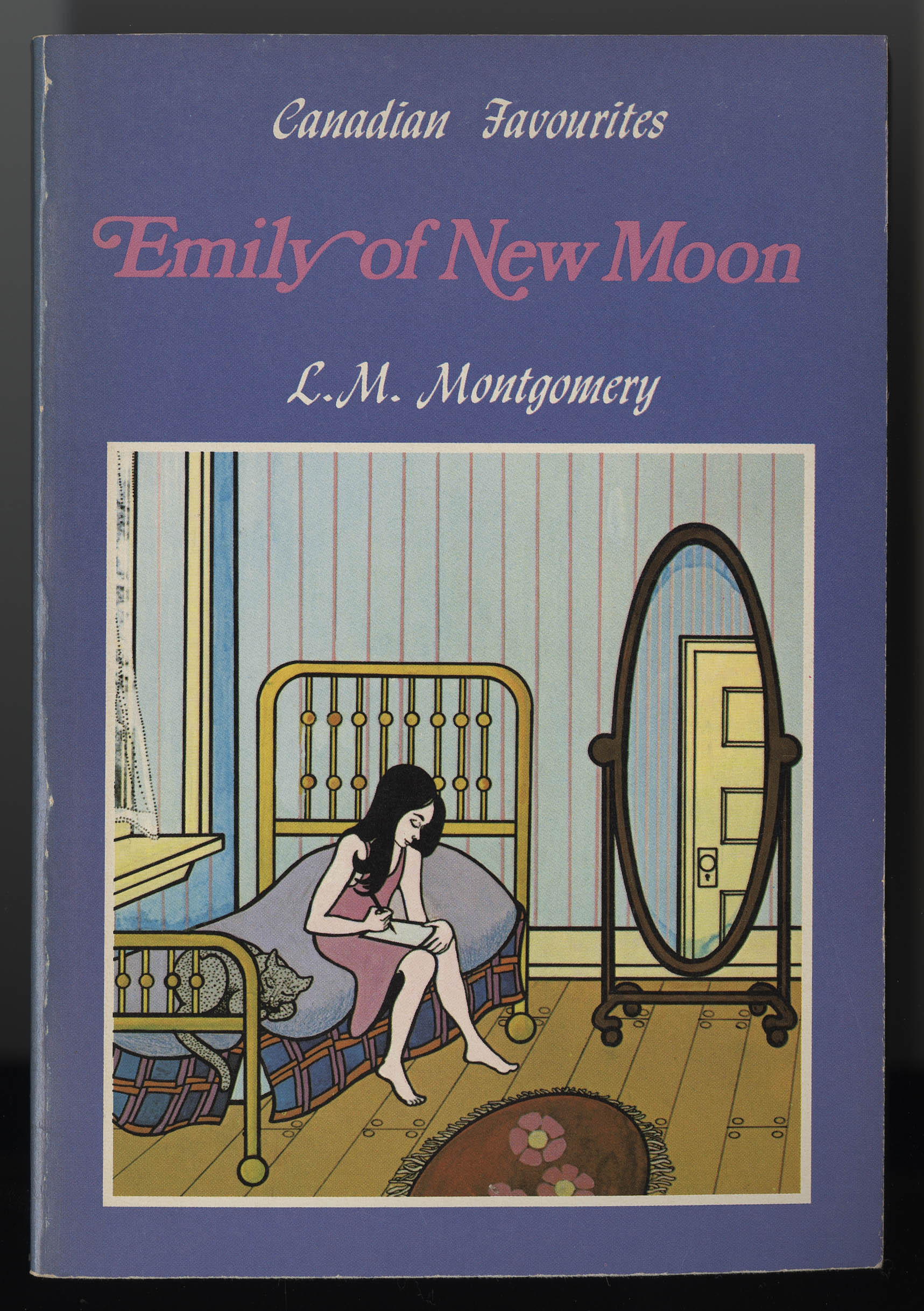 patriotic plays and flag drills by Canadianist Edith Lelean Groves, including her “All Canadian Entertainment Series” (1917 onwards) and Marshall Saunders’s Beautiful Joe, an 1893 “autobiography” of a dog first published by McClelland, Goodchild & Stewart in 1918. In a letter to Saunders after Beautiful Joe’s first publication, a friend wrote: “ ‘Beautiful Joe’ I have read with much interest and you have surely won eternal thanks from dogs for furnishing this life of one of them in a way to move all human hearts that are not petrified”. Beautiful Joe was one of the company’s top sellers; its tenth print order by M&S in 1934 was for 2500 copies, according to notes taken by scholar George Parker during the 1960s when conducting research at the M&S offices.
patriotic plays and flag drills by Canadianist Edith Lelean Groves, including her “All Canadian Entertainment Series” (1917 onwards) and Marshall Saunders’s Beautiful Joe, an 1893 “autobiography” of a dog first published by McClelland, Goodchild & Stewart in 1918. In a letter to Saunders after Beautiful Joe’s first publication, a friend wrote: “ ‘Beautiful Joe’ I have read with much interest and you have surely won eternal thanks from dogs for furnishing this life of one of them in a way to move all human hearts that are not petrified”. Beautiful Joe was one of the company’s top sellers; its tenth print order by M&S in 1934 was for 2500 copies, according to notes taken by scholar George Parker during the 1960s when conducting research at the M&S offices. 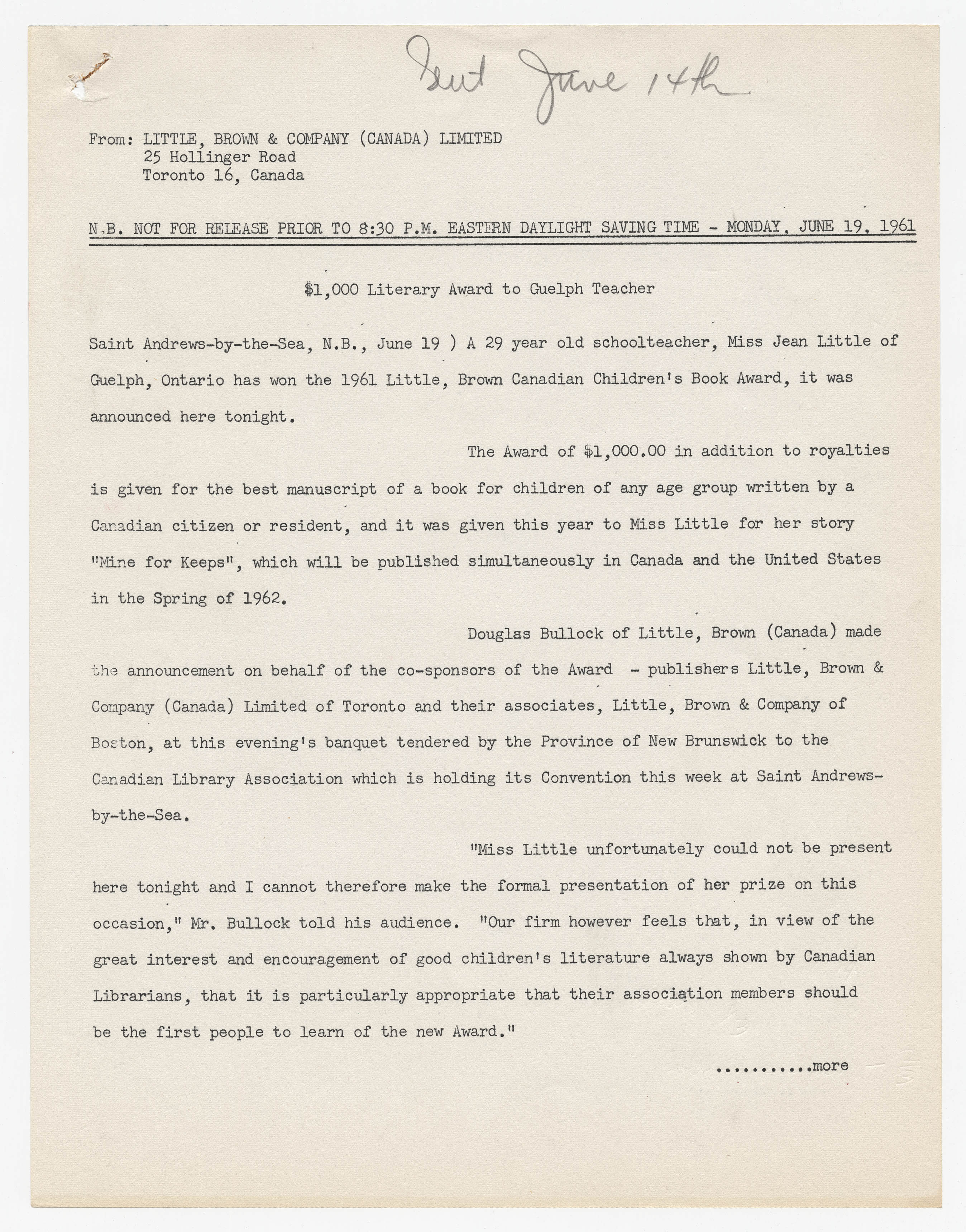
In the 1950s and 60s, under the direction of publisher Jack McClelland (son of founder John McClelland) and editor-in-chief S.J. Totton, Canadian children’s literature flourished at M&S through the publication of “juveniles” by noted authors such as Farley Mowat, Pierre Berton, Jean Little, and Scott Young. M&S continued to act as Canadian agents for various American publishers, particularly Little, Brown & Co. and Atheneum. Together with Little, Brown & Co., Totton and McClelland published Guelph schoolteacher Jean Little’s Home from Afar, a family novel that deals with the death of a twin. On 21 January 1954, Helen L. Jones, children’s  book editor for Little, Brown wrote to Little: “At last I have the final readers’ report on Home from Afar and I am delighted to tell you we are in unanimous agreement as to its excellence. Congratulations on a beautifully disciplined piece of writing.” Later publications by Little included Mine for Keeps (1962), a tale about cerebral palsy-afflicted Sally, and its sequel, Spring Begins in March (1966). The former novel won the Little Brown Children’s Book Award in 1962. M&S and Little, Brown jointly published all three novels.
book editor for Little, Brown wrote to Little: “At last I have the final readers’ report on Home from Afar and I am delighted to tell you we are in unanimous agreement as to its excellence. Congratulations on a beautifully disciplined piece of writing.” Later publications by Little included Mine for Keeps (1962), a tale about cerebral palsy-afflicted Sally, and its sequel, Spring Begins in March (1966). The former novel won the Little Brown Children’s Book Award in 1962. M&S and Little, Brown jointly published all three novels.
Another female author who greatly contributed to M&S’s children’s list was 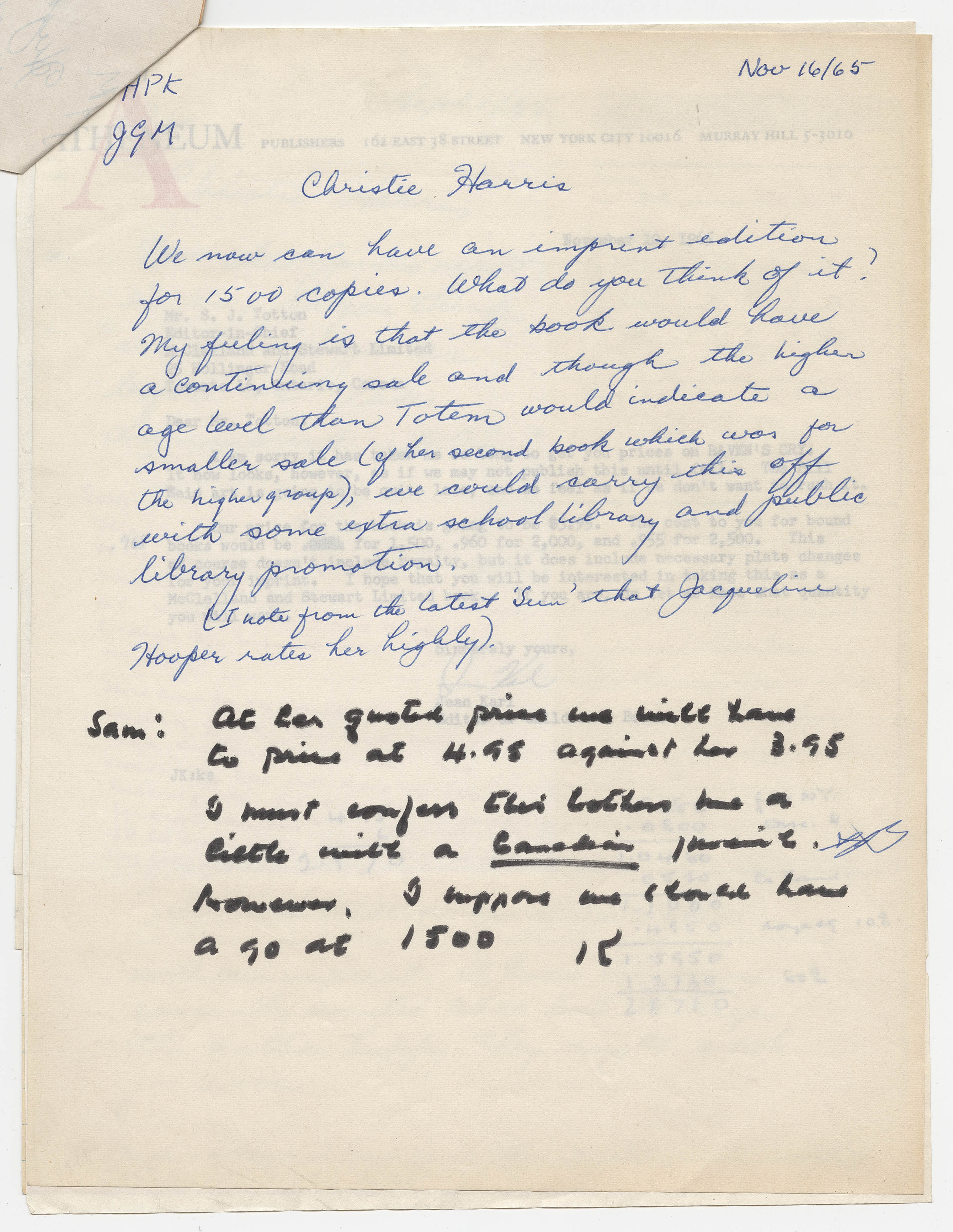 British Columbia native Christie Harris (1907-2002). Writing short stories and children’s books based on traditional tales of Aboriginal peoples of the North Pacific Coast, Harris sought publication with Atheneum, and had her work distributed in Canada by M&S. Her first book, Once Upon a Totem, with woodcuts by John Frazer Mills, was a collection of five legends of the Haida First Nations. In a handwritten note to his editorial staff on whether to take on Harris’s 1966 book, Raven’s Cry, Jack McClelland wrote that “the book would have a continuity sale and though the higher age level than Totem would indicate a smaller sale … we could carry this off with some extra school library and public library promotion. Raven’s Cry, illustrated by noted Haida artist Bill Reid, would
British Columbia native Christie Harris (1907-2002). Writing short stories and children’s books based on traditional tales of Aboriginal peoples of the North Pacific Coast, Harris sought publication with Atheneum, and had her work distributed in Canada by M&S. Her first book, Once Upon a Totem, with woodcuts by John Frazer Mills, was a collection of five legends of the Haida First Nations. In a handwritten note to his editorial staff on whether to take on Harris’s 1966 book, Raven’s Cry, Jack McClelland wrote that “the book would have a continuity sale and though the higher age level than Totem would indicate a smaller sale … we could carry this off with some extra school library and public library promotion. Raven’s Cry, illustrated by noted Haida artist Bill Reid, would  become Harris’s most well-known book, with a reprint edition in 1992, although Harris’s Mouse Woman series, with drawings by Douglas Tait, also continues to be popular, reprinted in a thirtieth anniversary trilogy edition by Vancouver children’s publisher Raincoast Books in 2007.
become Harris’s most well-known book, with a reprint edition in 1992, although Harris’s Mouse Woman series, with drawings by Douglas Tait, also continues to be popular, reprinted in a thirtieth anniversary trilogy edition by Vancouver children’s publisher Raincoast Books in 2007.
Farley Mowat, whose friendship with Jack McClelland is highlighted in Donna Thomson’s study on this site, was a major contributor to the children’s literature boom at M&S in the fifties and sixties. Lost in the Barrens (1956) established Mowat as a premier Canadian writer, not just in adult fiction and non-fiction, but in juvenile fiction as well. This 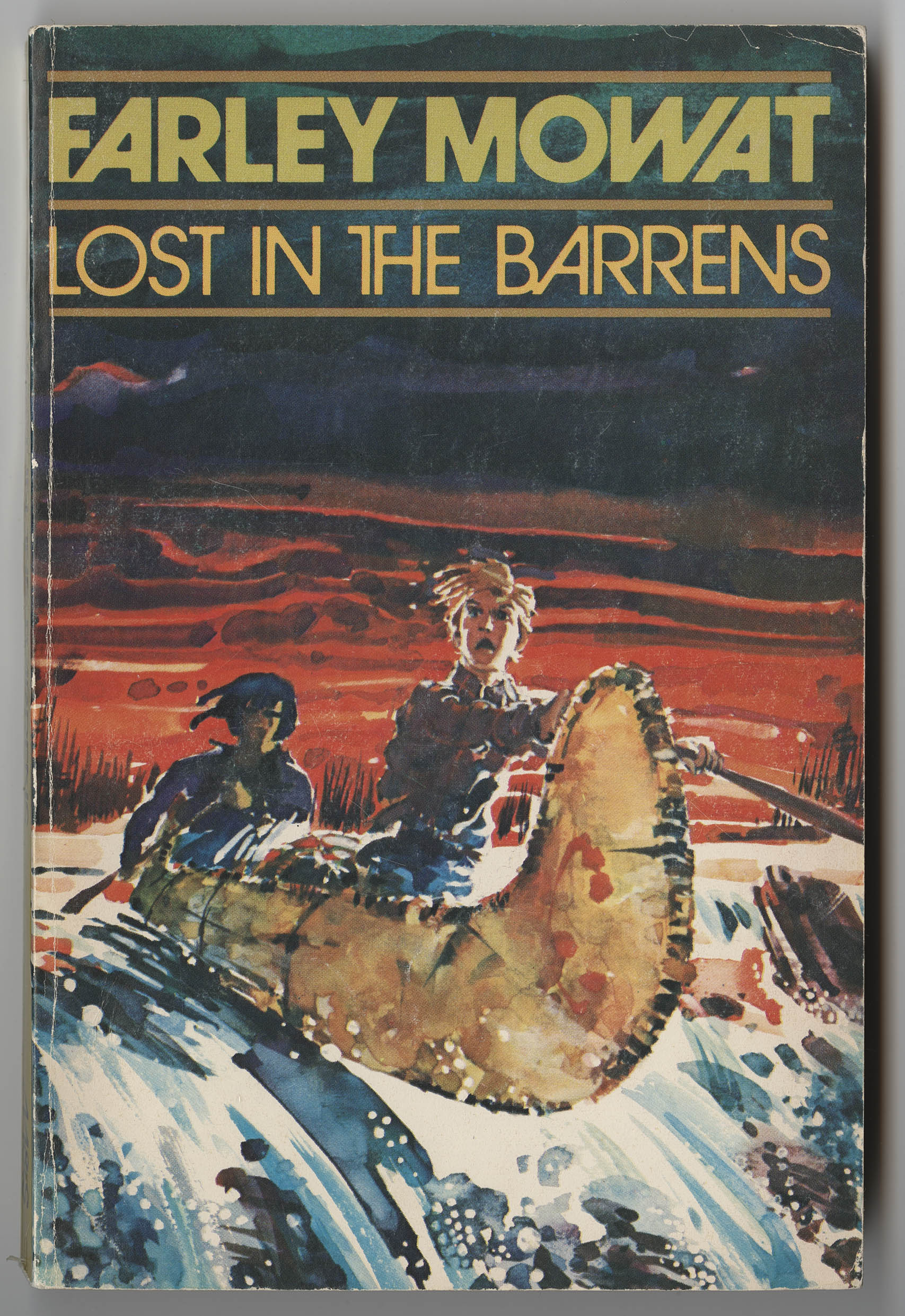 fast-paced novel about a seventeen-year old who must survive when he and his friend are separated from a caribou hunting group, was well-received throughout Canada. Unlike most of Mowat’s work, which was immediately acquired by M&S, the manuscript for Lost in the Barrens was shopped around to several publishers including Macmillan of Canada and Little, Brown, before Jack McClelland decided that M&S should publish the book in Canada. The Atlantic Monthly Press in Boston sought U.S. co-publication and director Dudley H. Cloud wrote McClelland on 28 March 1955 with “high hopes for it. To [me] the material on survival is fascinating. I hope we can get a classic juvenile from it.”
fast-paced novel about a seventeen-year old who must survive when he and his friend are separated from a caribou hunting group, was well-received throughout Canada. Unlike most of Mowat’s work, which was immediately acquired by M&S, the manuscript for Lost in the Barrens was shopped around to several publishers including Macmillan of Canada and Little, Brown, before Jack McClelland decided that M&S should publish the book in Canada. The Atlantic Monthly Press in Boston sought U.S. co-publication and director Dudley H. Cloud wrote McClelland on 28 March 1955 with “high hopes for it. To [me] the material on survival is fascinating. I hope we can get a classic juvenile from it.” 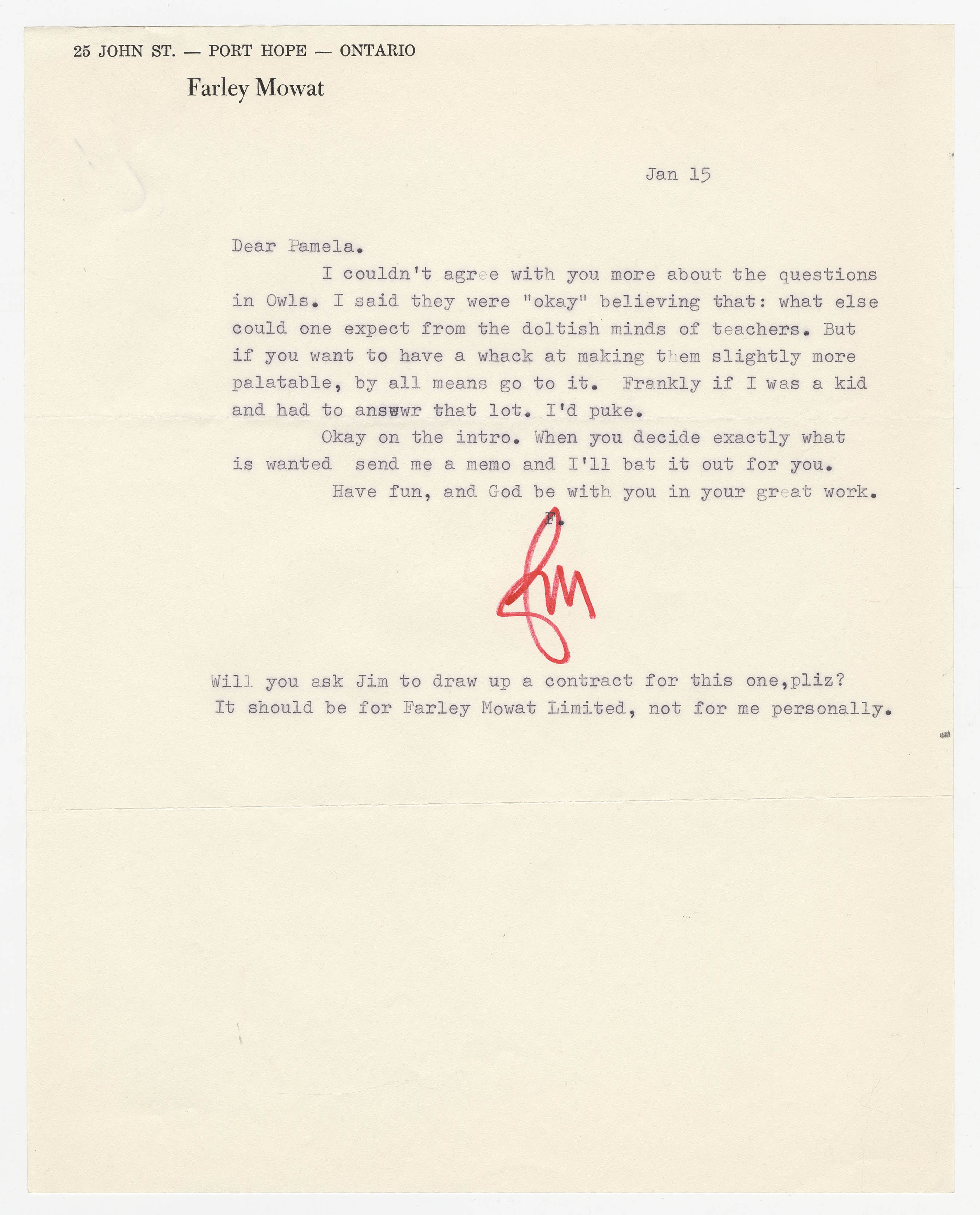 Owls in the Family (1961), a comedic family story, followed, as well as other children’s’ books, including The Dog Who Wouldn’t Be (1957). Owls in the Family was re-issued by M&S in 1973 in a school edition that included an author’s note and discussion questions composed by teachers. M&S children’s editor Pamela Fry later heavily edited the questions because Mowat criticized them, stating “what else could one expect from the doltish minds of teachers” and “[F]rankly if I was a kid and had to answer that lot, I’d puke”.
Owls in the Family (1961), a comedic family story, followed, as well as other children’s’ books, including The Dog Who Wouldn’t Be (1957). Owls in the Family was re-issued by M&S in 1973 in a school edition that included an author’s note and discussion questions composed by teachers. M&S children’s editor Pamela Fry later heavily edited the questions because Mowat criticized them, stating “what else could one expect from the doltish minds of teachers” and “[F]rankly if I was a kid and had to answer that lot, I’d puke”.
Pierre Berton’s The Secret World of Og (1961) was another huge  success for M&S. Four editions and over 200,000 copies have been sold to date. (Berton, personal website [http://pierreberton.com/author.htm#og]) This delightful children’s fantasy, with illustrations by William Winter, was based on stories Berton told to his children, and their own adventures with “green faced characters of curious habits.” The novel was adapted as both an animated television show and a play that still airs on the Canadian Broadcasting Corporation (CBC) and was staged at Vancouver’s Carousel Theatre in the summer of 2009. In accepting the book for publication, McClelland told his staff that Og was a “priority item” and that “Pierre has some very
success for M&S. Four editions and over 200,000 copies have been sold to date. (Berton, personal website [http://pierreberton.com/author.htm#og]) This delightful children’s fantasy, with illustrations by William Winter, was based on stories Berton told to his children, and their own adventures with “green faced characters of curious habits.” The novel was adapted as both an animated television show and a play that still airs on the Canadian Broadcasting Corporation (CBC) and was staged at Vancouver’s Carousel Theatre in the summer of 2009. In accepting the book for publication, McClelland told his staff that Og was a “priority item” and that “Pierre has some very 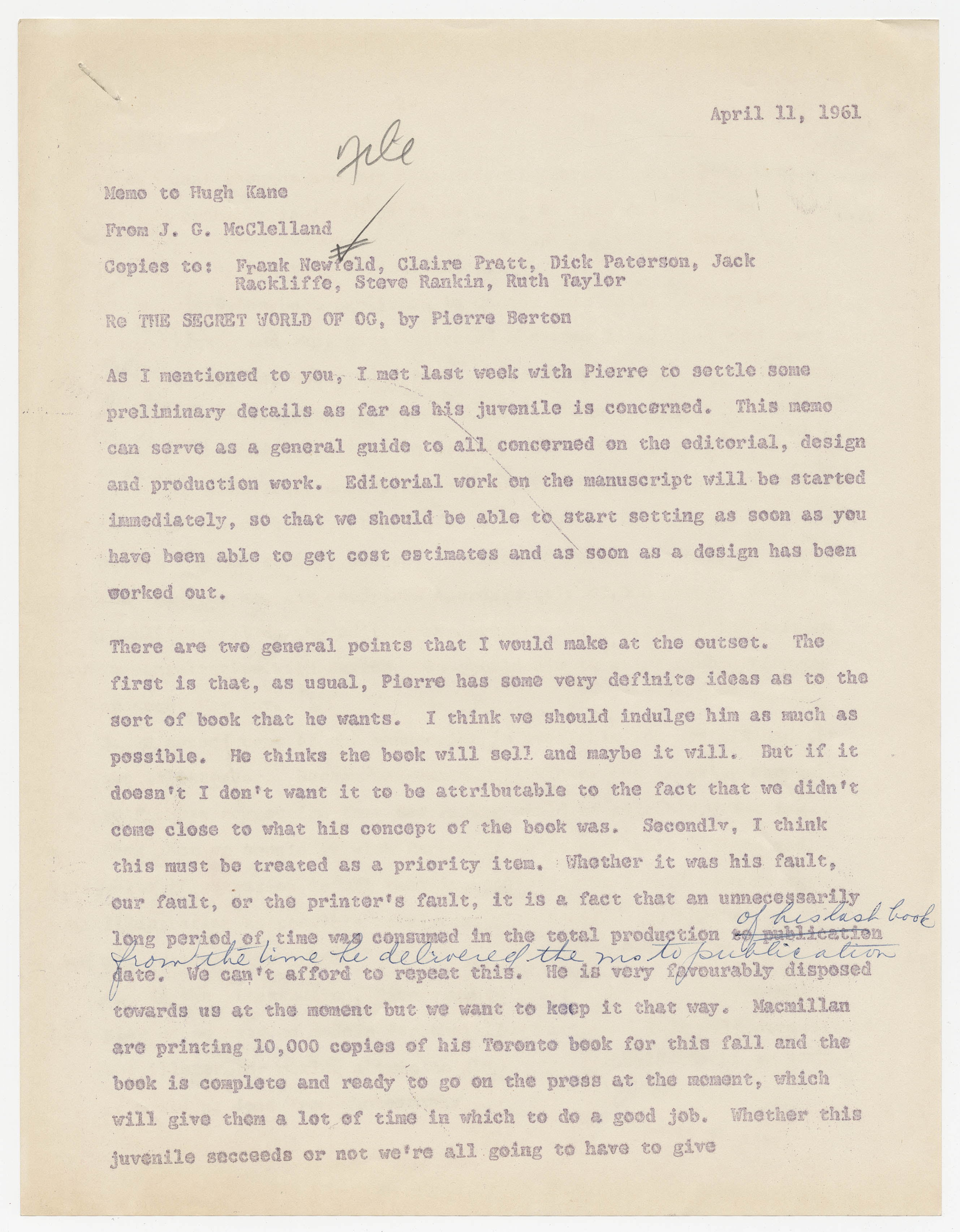 definite ideas as to the sort of book that he wants. I think we should indulge him as much as possible”. The title, in particular, was a contentious issue, as none of the staff liked “The Secret World of Og,” while Berton insisted on it. McClelland wrote to senior editor Jack Rackliffe on 7 June 1961, that Berton liked the word “‘secret’ – his kids like anything with that in the title.” Publicity and sales conference notes document the book’s extensive advertising campaign: radio stations and booksellers were sent tapes with excerpts read by Berton, and stores were sent displays with an “Og Mask and poster mounted on stick with suction cup.”
definite ideas as to the sort of book that he wants. I think we should indulge him as much as possible”. The title, in particular, was a contentious issue, as none of the staff liked “The Secret World of Og,” while Berton insisted on it. McClelland wrote to senior editor Jack Rackliffe on 7 June 1961, that Berton liked the word “‘secret’ – his kids like anything with that in the title.” Publicity and sales conference notes document the book’s extensive advertising campaign: radio stations and booksellers were sent tapes with excerpts read by Berton, and stores were sent displays with an “Og Mask and poster mounted on stick with suction cup.”
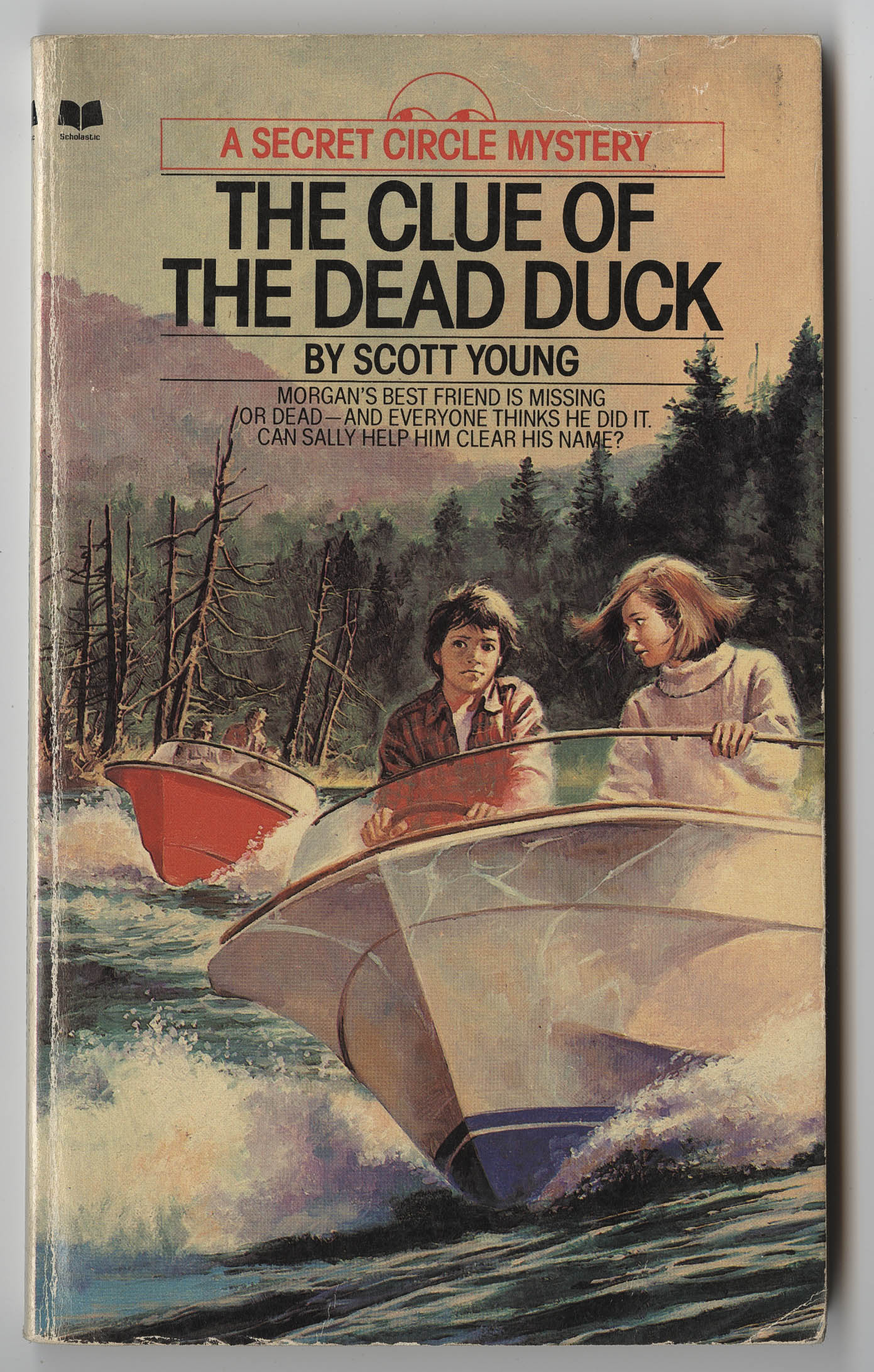 McClelland did not just rely on bestselling Canadian authors to build his children’s list. In 1959, he appointed Arthur Hammond as advisor on children’s books. Hammond conducted a yearlong survey on children’s reading habits and preferences. From the results, the popular series The Secret Circle was born, with Hammond as general editor. These books, written by Canadian authors including Hammond, Saskatchewan journalist Robert Collins, and others were set against a Canadian landscape with 10-12 year olds as the protagonists in a ghost, mystery, or detective story. In direct competition with this series was the Macmillan of Canada series, “Great Stories of Canada,” which had begun in 1953. Hammond, in fact, sent a note to McClelland on 9 August 9 1961 saying: “I find tonight that, for what its worth,
McClelland did not just rely on bestselling Canadian authors to build his children’s list. In 1959, he appointed Arthur Hammond as advisor on children’s books. Hammond conducted a yearlong survey on children’s reading habits and preferences. From the results, the popular series The Secret Circle was born, with Hammond as general editor. These books, written by Canadian authors including Hammond, Saskatchewan journalist Robert Collins, and others were set against a Canadian landscape with 10-12 year olds as the protagonists in a ghost, mystery, or detective story. In direct competition with this series was the Macmillan of Canada series, “Great Stories of Canada,” which had begun in 1953. Hammond, in fact, sent a note to McClelland on 9 August 9 1961 saying: “I find tonight that, for what its worth, 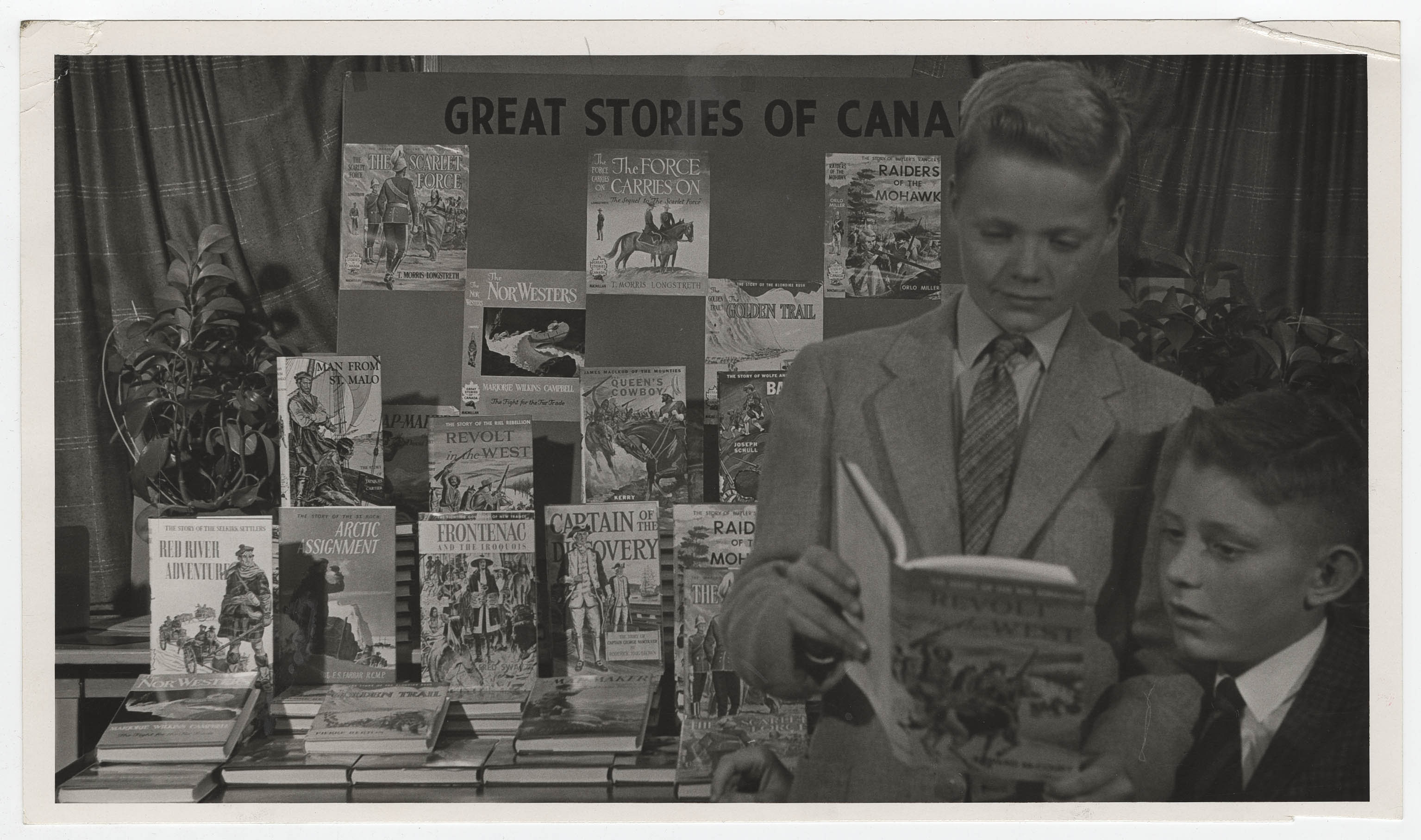 MacMillan’s [sic] seem to know all about what we’re doing on the juveniles … I suppose that one of the authors we’ve discussed it with has mentioned it to someone there … You didn’t tell them did you?”. Both Mowat and Berton were asked to write for the series but declined. Scott Young, who had already established himself as a premier juvenile author with the hockey book Scrubs on Skates (1952), penned two of the series’ ten novels. Hammond and the M&S editorial team often provided plots for the
MacMillan’s [sic] seem to know all about what we’re doing on the juveniles … I suppose that one of the authors we’ve discussed it with has mentioned it to someone there … You didn’t tell them did you?”. Both Mowat and Berton were asked to write for the series but declined. Scott Young, who had already established himself as a premier juvenile author with the hockey book Scrubs on Skates (1952), penned two of the series’ ten novels. Hammond and the M&S editorial team often provided plots for the  writers, many of whom were found through direct manuscript submission to editors or the Little Brown Children’s Book Award contest. Through 1962, M&S and Little, Brown jointly issued six titles under the latter’s imprint, with four more following in September 1963. The series did well at first, with a telecast of Hammond’s The Secret Tunnel Treasure broadcast on the CBC in January 1964, and an inquiry for Spanish translation rights; however, by the end of that year, sales had declined and a significant publicity campaign was launched. No new titles were published after 1963, although M&S reprinted four of the books in paperback in 1981.
writers, many of whom were found through direct manuscript submission to editors or the Little Brown Children’s Book Award contest. Through 1962, M&S and Little, Brown jointly issued six titles under the latter’s imprint, with four more following in September 1963. The series did well at first, with a telecast of Hammond’s The Secret Tunnel Treasure broadcast on the CBC in January 1964, and an inquiry for Spanish translation rights; however, by the end of that year, sales had declined and a significant publicity campaign was launched. No new titles were published after 1963, although M&S reprinted four of the books in paperback in 1981.
In the 1970s, M&S had another runaway success with Mordecai Richler’s Jacob Two-Two Meets the Hooded Fang, an adventure story about a lonely young boy who must repeat everything he says in order to gain attention from his family. Like Berton’s book, Richler’s Jacob Two-Two received mixed reader responses, including confusion about 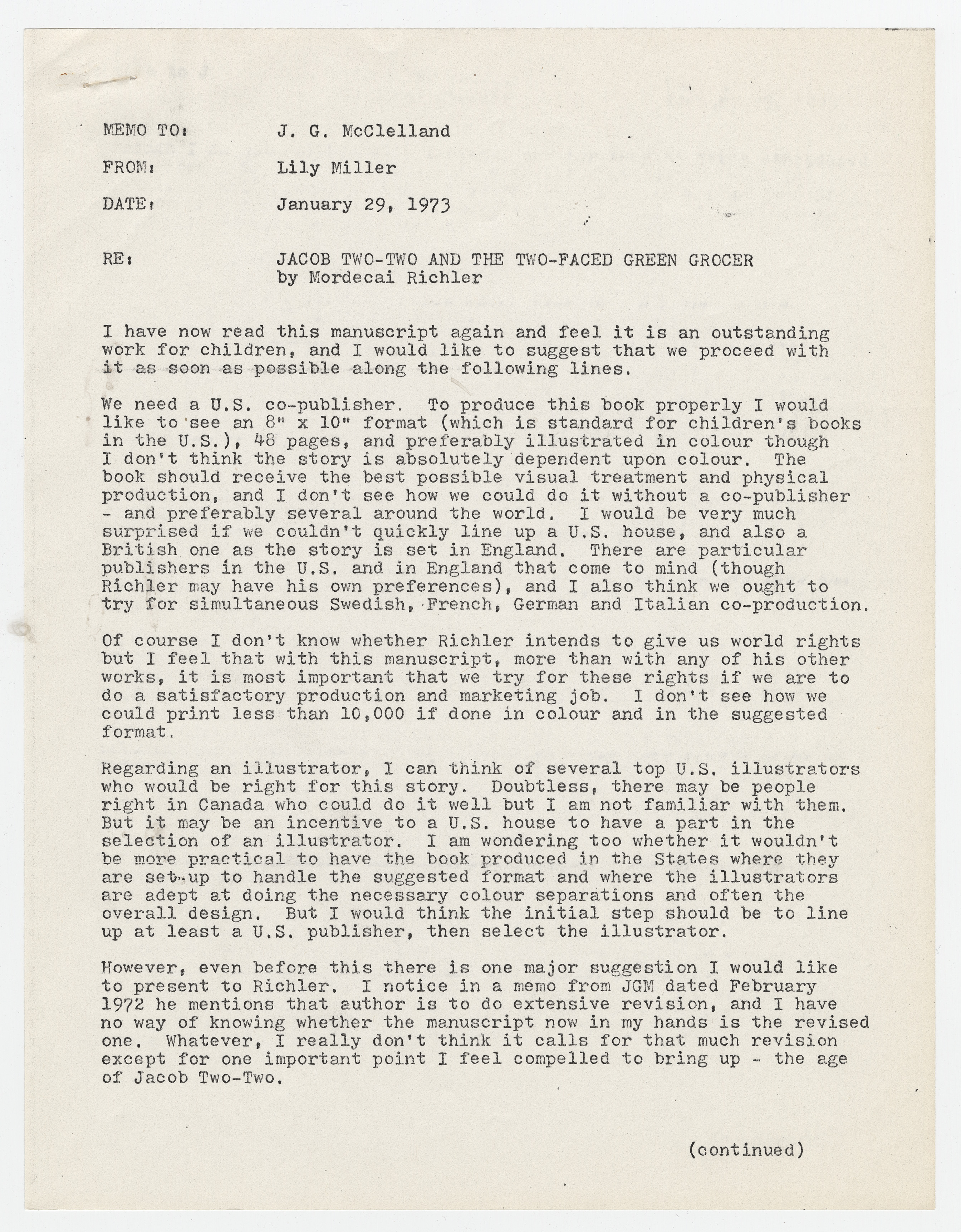 its genre. One report noted that an 11-year old felt “the humour was more on the level of the 7 year old.” Another report stated, “I am not quite sure what this is supposed to be—a juvenile or a satire.” Senior trade editor Lily Poritz Miller, on the other hand, identified Jacob Two-Two as “an outstanding work for children” which needed both illustrations and a U.S. co-publisher. Jacob Two-Two was jointly released in 1975 by M&S, Andre Deutsch in the U.K., and Pantheon in the U.S., with illustrations by Fritz Wegner. It was wildly successful: 10,276 copies were sold by late 1975, with a back order of 264 copies. The book won awards from both the Canadian Association of Children’s Librarians
its genre. One report noted that an 11-year old felt “the humour was more on the level of the 7 year old.” Another report stated, “I am not quite sure what this is supposed to be—a juvenile or a satire.” Senior trade editor Lily Poritz Miller, on the other hand, identified Jacob Two-Two as “an outstanding work for children” which needed both illustrations and a U.S. co-publisher. Jacob Two-Two was jointly released in 1975 by M&S, Andre Deutsch in the U.K., and Pantheon in the U.S., with illustrations by Fritz Wegner. It was wildly successful: 10,276 copies were sold by late 1975, with a back order of 264 copies. The book won awards from both the Canadian Association of Children’s Librarians  and the Canadian Booksellers’ Association, and was adapted to film and radio serialization that year, as well as an animated television series in 2003. Following the Hooded Fang’s success, Richler followed with two other Jacob Two-Two books before his death in 2001.
and the Canadian Booksellers’ Association, and was adapted to film and radio serialization that year, as well as an animated television series in 2003. Following the Hooded Fang’s success, Richler followed with two other Jacob Two-Two books before his death in 2001.
In 1996, M&S acquired Montreal-based children’s publishing house Tundra Books and moved the firm to Toronto. Tundra was established by writer and editor May Cutler in 1968. Its authors include Cutler herself (Breaking Free), Janet Lunn (Double Spell; Laura Secord: A Story of Courage), Marthe Jocelyn (Would You; How It Happened in Peach Hill) and Cary Fagan (Kaspar Snit series). Tundra’s booklist also includes the beloved Canadian picture book The Hockey Sweater (1979; English translation: 1984), Roch Carrier’s allegorical tale of a young boy outgrowing his Montreal Canadiens sweater, and accidentally receiving a Toronto Maple Leafs jersey, showing the divide between French and English-speaking Canada. A passage from this book appears on the 2002 Canadian five-dollar bill (“The Spirit of Hockey,” [http://archives.cbc.ca/sports/hockey/topics/1546/]). Tundra acquired Canadian rights to Ontario author Julie Johnston’s novels in 2003. Johnson’s celebrated debut Hero of Lesser Causes (1992) involving the spirited Keely who faces challenges when her brother is diagnosed with polio, and Johnson’s second novel, Adam and Eve and Pinch-Me, about foster home teen Sara Moone, won numerous awards, including back-to-back Governor General's Literary Awards [http://www.collectionscanada.gc.ca/read-up-on-it/015020-6043-e.html]. In recent years, Tundra has expanded its 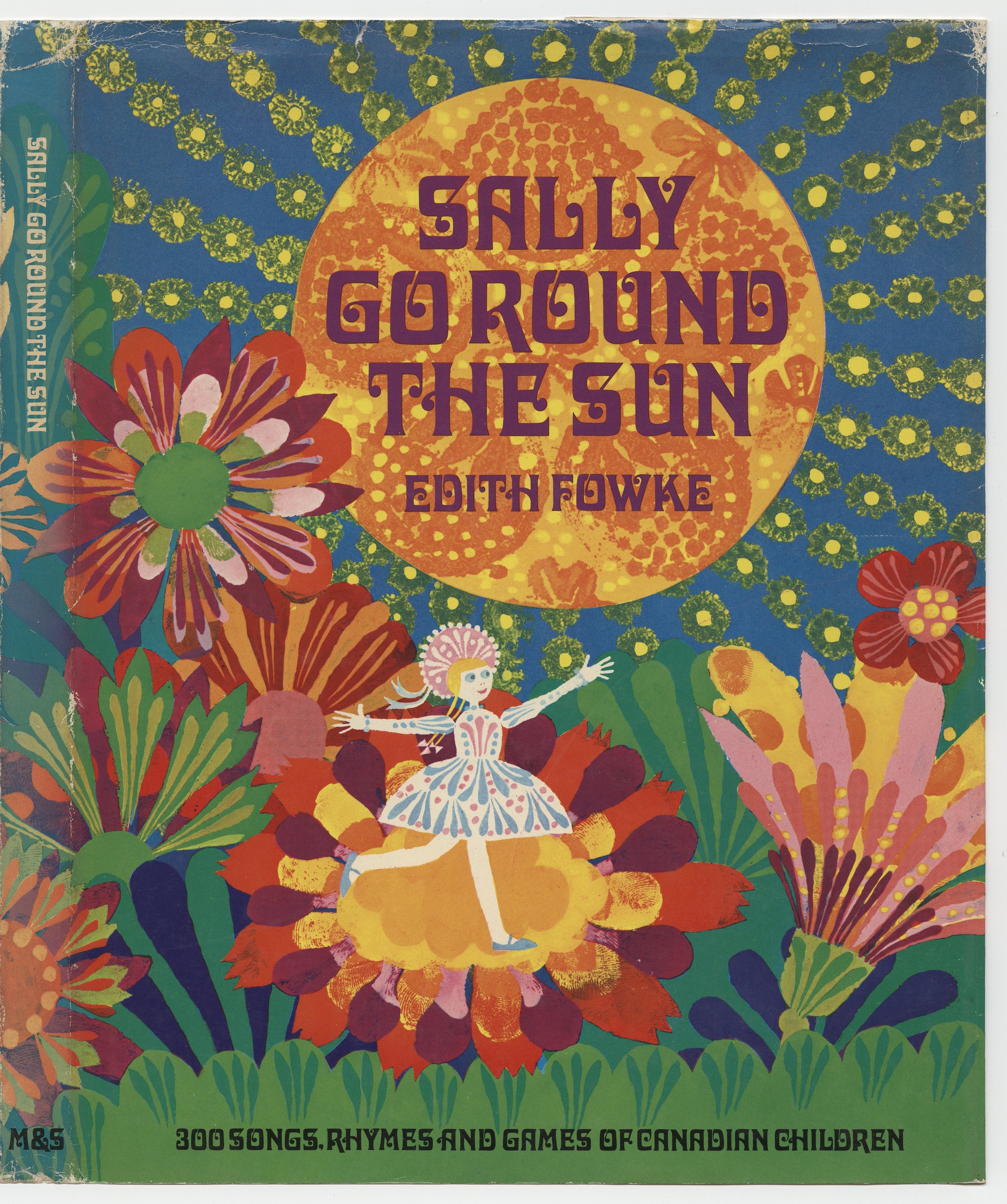 definition of children’s books to include non-fiction such as fashion personality Jeanne Beker’s Passion for Fashion: Careers in Style (2008), and comic book writer J. Torres’s teen graphic novel series Alison Dare (originally published by Oni Press; Tundra publishing date: 2010)
definition of children’s books to include non-fiction such as fashion personality Jeanne Beker’s Passion for Fashion: Careers in Style (2008), and comic book writer J. Torres’s teen graphic novel series Alison Dare (originally published by Oni Press; Tundra publishing date: 2010)
The explosion of children’s literature and the blurring of genre between children’s, adolescent, and adult books can be seen through McClelland & Stewart’s continuing pursuit of excellence and innovation in the field, begun with its early publication of works by A.A. Milne and L.M. Montgomery, the desire for crossover between M&S and Tundra, and indeed, between authors who defy age categorization in their writing.
Baker, Deirdre and Ken Setterington. A Guide to Canadian Children's Books in English. Toronto: McClelland & Stewart, 2003.
The Canadian Children’s Book Centre. [http://www.bookcentre.ca]
The Canadian Society of Children's Authors, Illustrators, and Performers. [http://www.canscaip.org]
Children’s Literature Service – Library and Archives Canada. [http://www.collectionscanada.gc.ca/childrenliterature/index-e.html]
Pouliot, Suzanne, Judith Saltman, and Gail Edwards. "Publishing for Children and Students." In History of the Book in Canada, ed. Carole Gerson and Jacques Michon, 3: 215-26. Toronto: University of Toronto Press, 2007.
McClelland & Stewart Website. [http://www.mcclelland.com/about/index.html]
Tundra Books Website. [http://www.tundrabooks.com]
McClelland & Stewart Ltd. fonds, McMaster University















